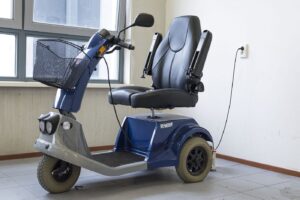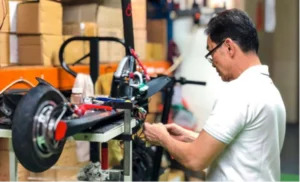With the right tools, a mobility scooter can help you stay independent and mobile. However, like any other vehicle, they can develop problems over time. Knowing how to deal with common problems can save you time and money. A little DIY knowledge can help solve everything from battery problems to minor mechanical issues. This book discusses some common problems and gives you useful advice on how to deal with them yourself.
How to Maintain and Repair Batteries
The battery is one of the most damaged parts of an electric scooter. The battery is very important to the operation of your scooter, and how well it works can have a big impact on your ride. To ensure that your battery lasts longer, regular maintenance is required. Make sure that there is no corrosion on the battery terminals. If your range is decreasing or the battery is charging slowly, you can check the connections between the batteries. Tighten any connections that are not tight and make sure that the battery is in the correct position. If your scooter’s charger isn’t charging, check it for damage and make sure it’s connected properly. If the battery has reached the end of its life, it may need to be replaced.
Tire Maintenance and Replacement
Another important part of keeping your scooter in good condition is maintaining your tires. Over time, tires can become worn or damaged, making your scooter less efficient. Check your tire pressure regularly and make sure it’s at the correct level according to your scooter’s owner’s manual. Low tire pressure can make your vehicle run sluggishly and wear out faster. If you see a flat tire, you may need to buy a new one. For solid tires, check for cracks or other signs of wear and replace them if any are found. You can usually replace your tires yourself if you know how to use simple tools. Make sure you follow the manufacturer’s instructions for your model.
How to Adjust and Repair Brakes
Brakes are important for safety and need to be maintained properly. If your scooter feels unstable or won’t stop, check your brakes. Check for worn brake pads and frayed or broken brake lines. Usually, adjusting your brakes involves adjusting the brake cable to make sure it is working properly. If you don’t know much about brakes, you can consult your scooter’s owner’s manual or seek professional help. Regularly checking and repairing your scooter’s brakes will ensure that it is safe and reliable.
Troubleshooting Motor and Controller Problems
A scooter’s motor and controller are its most important components, and if they have problems, it can reduce its usability. If the vehicle stops suddenly, moves erratically, or accelerates slowly, the motor or controller may be damaged. First, make sure that the connection between the motor and controller is secure and free of corrosion. Check the wiring for signs of damage. If the problem persists, a more extensive repair or replacement may be necessary. If you’re not sure what to do, consult your scooter’s owner’s manual for troubleshooting tips or seek professional help.
Check the electrical system
A scooter’s electrical system consists of the wires, fuses, and connections that are necessary for it to function. Check the wiring regularly for damage or loose connections. A blown fuse can cause your scooter to suddenly lose power or behave erratically. Check for blown fuses in the fuse box, which is usually located near the battery. Replacing a fuse is usually simple, but make sure you use the correct type and rating, as specified in your scooter’s manual.
Regular cleaning and maintenance
Keeping your scooter clean is important for the health and longevity of your scooter. Dust, dirt, and water can damage various parts and cause them to wear out faster than necessary. Clean the outside of your scooter regularly with a damp cloth. Do not use harsh chemicals that can damage the surface. Make sure there is nothing on the scooter’s chassis. Dirt can get into moving parts and cause problems. Regularly cleaning the battery terminals and charging port will prevent them from rusting and keep the connections strong.
Adding and Changing Parts
To ride better or feel better, your scooter’s parts may need to be upgraded or modified. With the right tools and the giving you trouble, or if you’re not sure how to fix it, you should talk to a professional. If you don’t know how to fix something, you could end up doing more damage and putting your scooter’s safety at risk. Taking care of your mobility scooter regularly and getting it serviced by a professional when needed can keep it in great shape.
Conclusion
It may seem hard to maintain and fix your mobility scooter, but many problems can be fixed by yourself with a little knowledge and planning. Checking the battery, tires, brakes, and electrical system on a regular basis can keep your scooter in good shape and make it last longer. Some repairs can be done at home, but if the problem is too complicated, don’t be afraid to get help from a professional. If you take care of your scooter, you can have a safe and reliable mobility aid that helps you stay independent and makes your daily life better.
FAQs
What is the best way to check the battery in my mobility scooter?
At least once a month, you should check the battery in your scooter. Make sure the connections are tight and the terminals are clean.
What should I do if the tire on my mobility scooter keeps taking air out?
If your tire is losing air often, check it for damage or holes. You might have to get a new tire or have it fixed by a professional.
3. How can I tell if the brakes on my scooter need to be adjusted?
You might need to adjust the brakes if you notice that the scooter doesn’t stop well or if they feel loose or don’t work at all.
4. What kind of upkeep does the motor on the scooter need?
Check the connections and wiring of the motor often for damage or signs of wear. Make sure the motor works smoothly and doesn’t make any strange noises.
5. Can I make changes to my mobility scooter by myself?
Yes, you can do a lot of the upgrades and changes yourself. Just be sure to follow the directions from the maker and use parts that work with the machine. If you’re not sure, talk to a professional.


